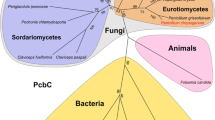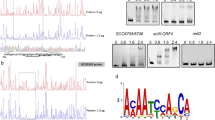Abstract
Transcript levels of several key genes responsible for cephalosporin C (CPC) biosynthesis and transport have been determined using qPCR analysis of Acremonium chrysogenum strains differing more than 100-fold in the levels of CPC production. The expression of genes involved in the final steps of CPC production was significantly increased in the high-producing RNCM F-4081D strain compared to the wild-type ATCC 11550 strain. Different dynamics in the course of cultivation was observed for the genes known to be involved in the transport of CPC intermediates between subcellular compartments. Overall, comparative expression analysis showed balanced and fine-tuned expression of the genes responsible for CPC biosynthesis and transport in the genetically selected A. chrysogenum RNCM F-4081D strain, reflecting its capacity to overcome known CPC biosynthesis “bottlenecks” and produce CPC of high yield and purity.


Similar content being viewed by others
References
Bartoshevich Y, Novak M, Domratcheva A, Skryabin K (2009) Method of cephalosporin C biosynthesis by using new Acremonium chrysogenum strain, RNCM NO F-4081D. No 2426793, Priority 10.05.2011
Brakhage AA (1998) Molecular regulation of β-Lactam biosynthesis in filamentous fungi. Microbiol Mol Biol Rev 62:547–585
Demain AL, Elander RP (1999) The beta-lactam antibiotics: past, present, and future. Antonie Van Leeuwenhoek 75:5–19
Díez B, Velasco J, Marcos AT, Rodríguez M, De La Fuente JL, Barredo JL (2000) The gene encoding gamma-actin from the cephalosporin producer Acremonium chrysogenum. Appl Microbiol Biotechnol 54:786–791
Dumina M, Zhgun A, Domracheva A, Novak M, El’darov M (2012) Chromosomal polymorphism of Acremonium chrysogenum strains producing cephalosporin C. J Genet 48:778–784. doi:10.1134/S1022795412050067
Elander RP (2003) Industrial production of beta-lactam antibiotics. Appl Microbiol Biotechnol 61:385–392
Felipe M, Rogelin R, Azevedo M, Astolfi-Filho S (1993) Extended application of an efficient method for RNA isolation from different organisms. Biotechnol Tech 7:639–644
Fernández FJ, Fierro F, López-Calleja AC, Barrios-González J, Cuadra T (2012) Solid-state and submerged fermentations show different gene expression profiles in cephalosporin C production by Acremonium chrysogenum. J Mol Microbiol Biotechnol 22:126–134
García-Estrada C, Barreiro C, Jami MS, Martín-González J, Martín JF (2013) The inducers 1,3-diaminopropane and spermidine cause the reprogramming of metabolism in Penicillium chrysogenum, leading to multiple vesicles and penicillin overproduction. J Proteomics 85:129–159
Gutiérrez S, Velasco J, Marcos AT, Fernández FJ, Fierro F, Barredo JL, Díez B, Martín JF (1997) Expression of the cefG gene is limiting for cephalosporin biosynthesis in Acremonium chrysogenum. Appl Microbiol Biotechnol 48:606–614
Harris DM, van der Krogt ZA, Klaassen P, Raamsdonk LM, Hage S, van den Berg MA, Bovenberg RAL, Pronk JT, Daran JM (2009) Exploring and dissecting genome-wide gene expression responses of Penicillium chrysogenum to phenylacetic acid consumption and penicillin G production. BMC Genom 10:75
Jami MS, Barreiro C, García-Estrada C, Martín JF (2010) Proteome analysis of the penicillin producer Penicillium chrysogenum: characterization of protein changes during the industrial strain improvement. Mol Cell Proteomics 9:1182–1198
Lewinson O, Adler J, Sigal N, Bibi E (2006) Promiscuity in multidrug recognition and transport: the bacterial MFS Mdr transporters. Mol Microbiol 61:277–284
Liu Y, Gong G, Xie L, Yuan N, Zhu C, Zhu B, Hu Y (2010) Improvement of cephalosporin C production by recombinant DNA integration in Acremonium chrysogenum. Mol Biotechnol 44:101–109
Lu G, Moriyama EN (2004) Software review vector NTI, a balanced all-in-one sequence analysis suite. Softw Rev 5:378–388
Martín JF, Ullán RV, García-Estrada C (2010) Regulation and compartmentalization of β-lactam biosynthesis. Microb Biotechnol 3:285–299
Menne S, Walz M, Kück U (1994) Expression studies with the bidirectional pcbAB-pcbC promoter region from Acremonium chrysogenum using reporter gene fusions. Appl Microbiol Biotechnol 42(1):57–66
Newton G, Abraham E (1956) Isolation of cephalosporin C, a penicillin-like antibiotic containing D-alpha-aminoadipic acid. Biochem J 62:651–658
Paulsen IT, Sliwinski MK, Nelissen B, Goffeau A, Saier MH (1998) Unified inventory of established and putative transporters encoded within the complete genome of Saccharomyces cerevisiae. FEBS Lett 430:116–125
Rodríguez-Sáiz M, Lembo M, Bertetti L, Muraca R, Velasco J, Malcangi A, De La Fuente JL, Barredo JL (2004) Strain improvement for cephalosporin production by Acremonium chrysogenum using geneticin as a suitable transformation marker. FEMS Microbiol Lett 235:43–49
Schmitt EK, Hoff B, Kück U (2004) Regulation of cephalosporin biosynthesis. Adv Biochem Eng Biotechnol 88:1–43
Smith AW, Collis K, Ramsden M, Fox HM, Peberdy JF (1991) Chromosome rearrangements in improved cephalosporin C-producing strains of Acremonium chrysogenum. Curr Genet 19:235–237
Teijeira F, Ullán RV, Guerra SM, García-Estrada C, Vaca I, Martín JF (2009) The transporter CefM involved in translocation of biosynthetic intermediates is essential for cephalosporin production. Biochem J 418:113–124
Teijeira F, Ullán RV, Fernández-Aguado M, Martín JF (2011) CefR modulates transporters of beta-lactam intermediates preventing the loss of penicillins to the broth and increases cephalosporin production in Acremonium chrysogenum. Metab Eng 13:532–543
Ullán RV, Liu G, Casqueiro J, Gutiérrez S, Bañuelos O, Martín JF (2002) The cefT gene of Acremonium chrysogenum C10 encodes a putative multidrug efflux pump protein that significantly increases cephalosporin C production. Mol Genet Genomics 267:673–683
Ullán RV, Teijeira F, Guerra SM, Vaca I, Martín JF (2010) Characterization of a novel peroxisome membrane protein essential for conversion of isopenicillin N into cephalosporin C. Biochem J 432:227–236
Van Den Berg MA (2011) Impact of the Penicillium chrysogenum genome on industrial production of metabolites. Appl Microbiol Biotechnol 92:45–53
Van Den Berg MA, Albang R, Albermann K, Badger JH, Daran JM, Driessen AJM, Garcia-Estrada C, Fedorova ND, Harris DM, Heijne WHM, Joardar V, Kiel JAKW, Kovalchuk A, Martín JF, Nierman WC, Nijland JG, Pronk JT, Roubos JA, Van Der Klei IJ, Van Peij NNME, Veenhuis M, Von Döhren H, Wagner C, Wortman J, Bovenberg RAL (2008) Genome sequencing and analysis of the filamentous fungus Penicillium chrysogenum. Nat Biotechnol 26:1161–1168
Velasco J, Luis Adrio J, Angel Moreno M, Díez B, Soler G, Barredo JL (2000) Environmentally safe production of 7-aminodeacetoxycephalosporanic acid (7-ADCA) using recombinant strains of Acremonium chrysogenum. Nat Biotechnol 18:857–861
Acknowledgments
Supported by RFBR Grant 14-04-31515.
Author information
Authors and Affiliations
Corresponding author
Electronic supplementary material
Below is the link to the electronic supplementary material.
Rights and permissions
About this article
Cite this article
Dumina, M.V., Zhgun, A.A., Novak, M.I. et al. Comparative gene expression profiling reveals key changes in expression levels of cephalosporin C biosynthesis and transport genes between low and high-producing strains of Acremonium chrysogenum . World J Microbiol Biotechnol 30, 2933–2941 (2014). https://doi.org/10.1007/s11274-014-1721-1
Received:
Accepted:
Published:
Issue Date:
DOI: https://doi.org/10.1007/s11274-014-1721-1




